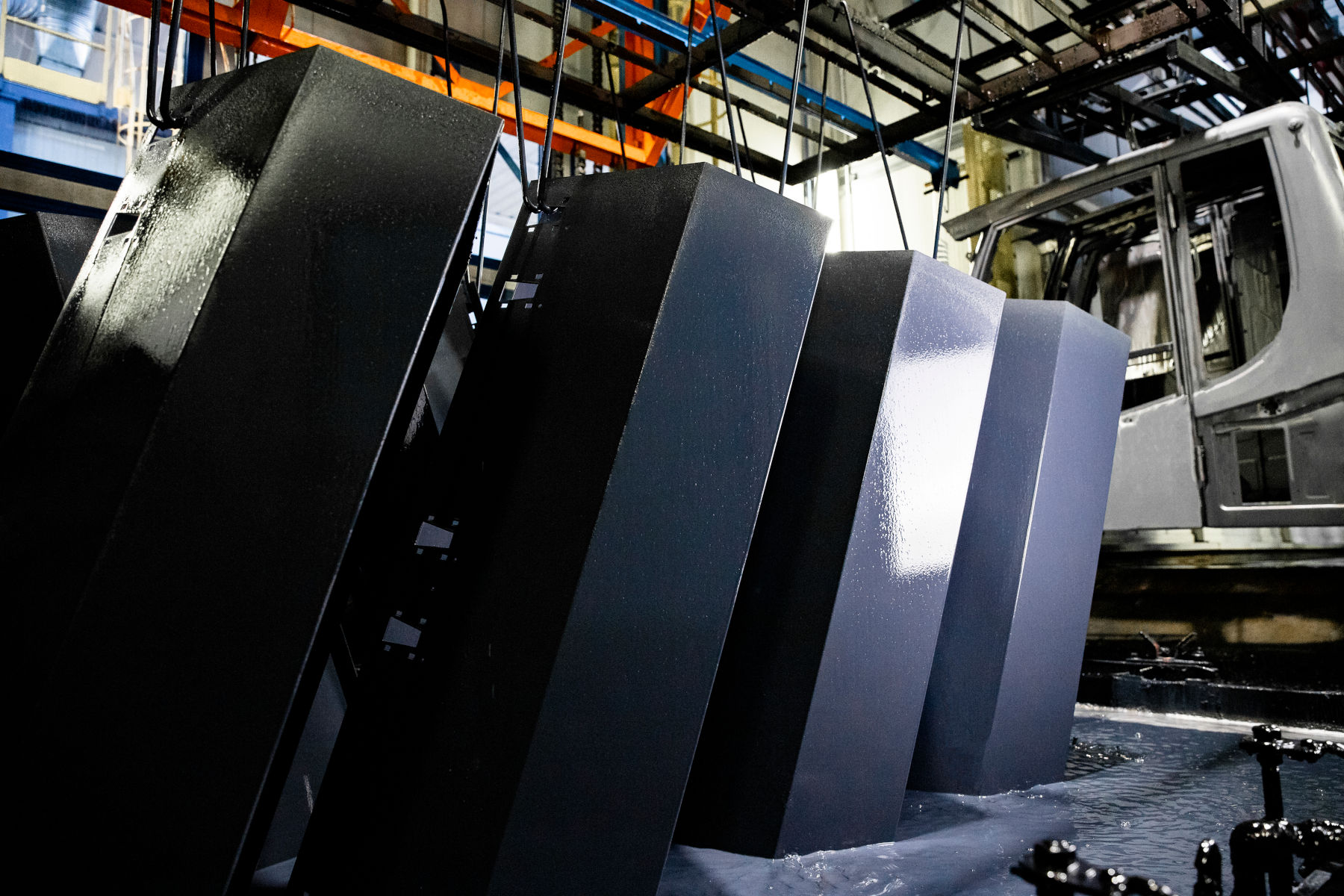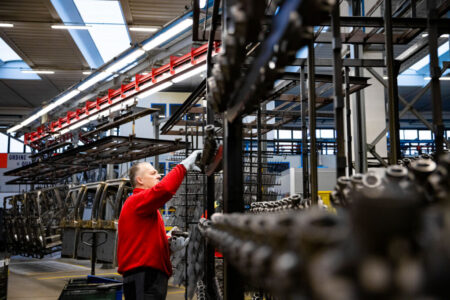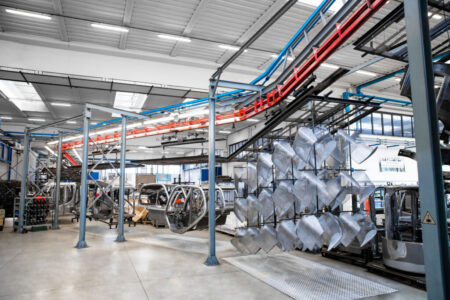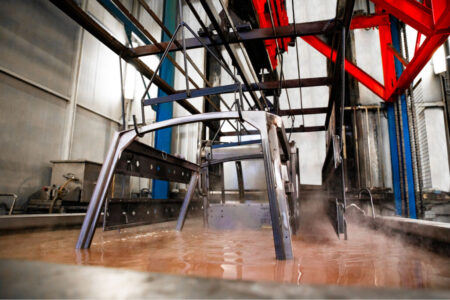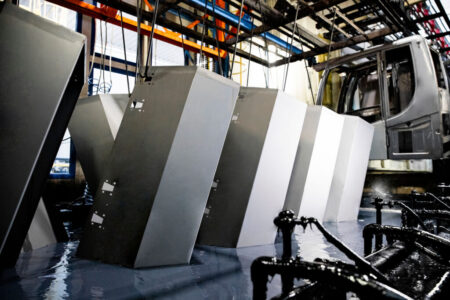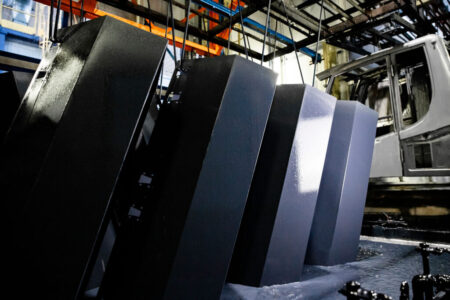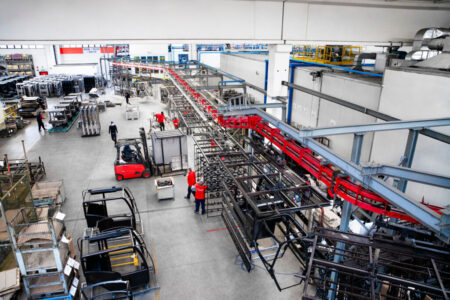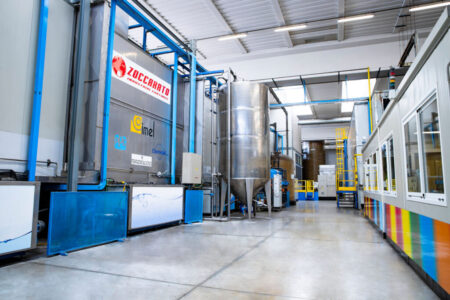against corrosion
E-coating is an epoxy resin process applied by electrodeposition to give the best corrosion resistance.
Our e-coating process (also known as electrodeposition coating) is carried out by immersion in a highly automated plant controlled remotely via PLC by highly qualified personnel. The plant is equipped with 11 stages, including immersion degreasing stages, which are crucial for the high level of cleaning of the products before coating.
One of the strengths of our cataphoresis process is the surface conversion phase to zinc salts (Caterpillar approved), through the deposition of a microcrystalline layer, which gives the parts high corrosion resistance, up to 700 hours according to ISO 9227 (on steel and iron alloys), and mechanical resistance with maximum flexibility values.
Being an electrodeposition cathodic treatment, it can only be carried out on metallic articles, including aluminium, cast iron, iron, steel and other alloys. Among other positive factors, it should be noted that cataphoresis allows better adhesion of subsequent finishing coats if required.
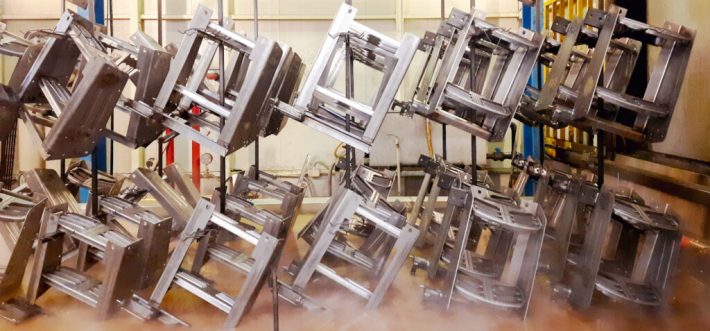
E-coating: the application process
What our e-coating process consists of
The process carried out in our plant consists of several initial stages of cleaning and pre-treatment, where through alkaline solutions, mains water, phosphating with zinc salts, demi and passivation, the items are prepared for the actual electrodeposition coating treatment. These are necessary steps, sought after by the highest quality standards and required by industrial specifications, to make the process itself impeccable and ensure that the paint subsequently settles without any type of problem.
Once these steps have been completed, e-coating takes place: in short, this is a process by electrodeposition in which the products, previously connected to the negative pole of an electric generator, are placed in a large tank where electrodes connected to the positive pole are also immersed. The electric field that develops gives rise to electrochemical phenomena that cause the paint to deposit on the workpiece.
Before entering the oven, a further stage certifies the quality of the treatment: the artefacts are washed with ultrafiltrate (UF), the liquid part of the bath from which the pigmentation is removed, extracted with special equipment, which then falls back into the tank to minimise paint loss.
In conclusion, as with other industrial painting techniques, the object enters the oven which, at the correct temperature, will polymerise the paint, making it permanent.
E-coating protects against corrosion and rust
Increasing the value of articles by e-coating
E-coating is an extremely important coating cycle, especially for articles that are subjected to stress in the course of their duties.
The implementation of cataphoresis treatment within the painting cycle increases the resistance of the goods to water, salt, wind, sun, snow and the action of time, preserving and protecting them from oxidation and rust like no other type of surface treatment.
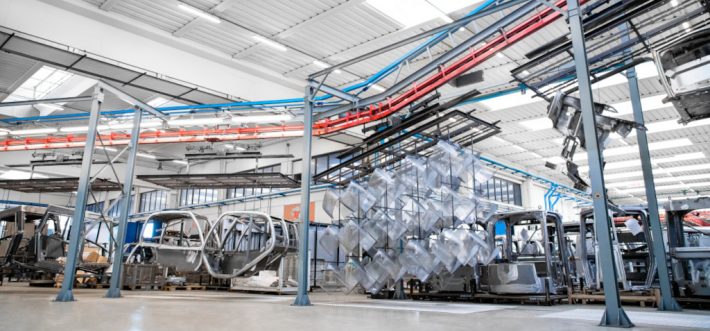
It is easy to see that this is not just a “simple” aesthetic coating, but a real factor capable of adding value to the product, extending its life cycle and increasing its quality from the end user’s point of view.
It is no coincidence that this technology is still widely used today in some of the most demanding markets and sectors, such as the automotive, agricultural machinery, earthmoving machinery and materials, marine and furniture industries, to name but a few.
After years of constant expansion and improvement, our e-coating plant is currently among the largest in Europe in terms of daily production capacity and size of items that can be treated, while maintaining the extreme quality of the service offered.
It is also for this reason that we can consider e-coating as the heart of our company, a strong point capable of differentiating both the customers who use it and our own company, which over the years has made it an essential strong point.
| Offers the best corrosion protection | |
| Our plant has 11 process steps and is one of the largest in Europe | |
| Ideal for even the most demanding markets | |
| Ideal for small and large items | |
| It is an epoxy resin process |
| Offers the best corrosion protection | |
| Our plant has 11 process steps and is one of the largest in Europe | |
| Ideal for even the most demanding markets | |
| Ideal for small and large items | |
| It is an epoxy resin process |
E-coating is an epoxy resin process applied by electrodeposition to give the best corrosion resistance.
Our e-coating process (also known as electrodeposition coating) is carried out by immersion in a highly automated plant controlled remotely via PLC by highly qualified personnel. The plant is equipped with 11 stages, including immersion degreasing stages, which are crucial for the high level of cleaning of the products before coating.
One of the strengths of our cataphoresis process is the surface conversion phase to zinc salts (Caterpillar approved), through the deposition of a microcrystalline layer, which gives the parts high corrosion resistance, up to 700 hours according to ISO 9227, and mechanical resistance with maximum flexibility values.
Being an electrodeposition cathodic treatment, it can only be carried out on metallic articles, including aluminium, cast iron, iron, steel and other alloys. Among other positive factors, it should be noted that cataphoresis allows better adhesion of subsequent finishing coats if required.

E-coating: the application process
What our e-coating process consists of
The process carried out in our plant consists of several initial stages of cleaning and pre-treatment, where through alkaline solutions, mains water, phosphating with zinc salts, demi and passivation, the items are prepared for the actual electrodeposition coating treatment. These are necessary steps, sought after by the highest quality standards and required by industrial specifications, to make the process itself impeccable and ensure that the paint subsequently settles without any type of problem.
Once these steps have been completed, e-coating takes place: in short, this is a process by electrodeposition in which the products, previously connected to the negative pole of an electric generator, are placed in a large tank where electrodes connected to the positive pole are also immersed. The electric field that develops gives rise to electrochemical phenomena that cause the paint to deposit on the workpiece.
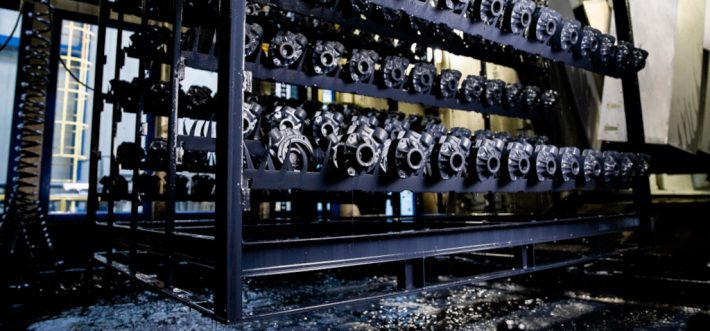
Before entering the oven, a further stage certifies the quality of the treatment: the artefacts are washed with ultrafiltrate (UF), the liquid part of the bath from which the pigmentation is removed, extracted with special equipment, which then falls back into the tank to minimise paint loss.
In conclusion, as with other industrial painting techniques, the object enters the oven which, at the correct temperature, will polymerise the paint, making it permanent.
E-coating protects against corrosion and rust
Increasing the value of articles by e-coating
E-coating is an extremely important coating cycle, especially for articles that are subjected to stress in the course of their duties.
The implementation of cataphoresis treatment within the painting cycle increases the resistance of the goods to water, salt, wind, sun, snow and the action of time, preserving and protecting them from oxidation and rust like no other type of surface treatment.

It is easy to see that this is not just a “simple” aesthetic coating, but a real factor capable of adding value to the product, extending its life cycle and increasing its quality from the end user’s point of view.
It is no coincidence that this technology is still widely used today in some of the most demanding markets and sectors, such as the automotive, agricultural machinery, earthmoving machinery and materials, marine and furniture industries, to name but a few.
After years of constant expansion and improvement, our e-coating plant is currently among the largest in Europe in terms of daily production capacity and size of items that can be treated, while maintaining the extreme quality of the service offered.
It is also for this reason that we can consider e-coating as the heart of our company, a strong point capable of differentiating both the customers who use it and our own company, which over the years has made it an essential strong point.

